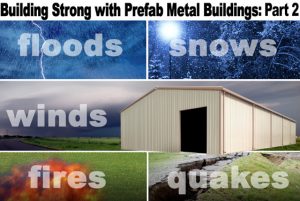Part 2: Safer Structures in Earthquakes and Snowstorms
Our previous blog covered how prefab metal buildings provide extra protection against windstorms, floods, and fires. Now let’s look at some of the other types of natural disasters inflicting billion-dollar structural damage.
Prefab Steel Buildings in Earthquakes
 The devastating earthquakes in Mexico last month killed hundreds of people, emphasizing the need for seismic-resistant building techniques.
The devastating earthquakes in Mexico last month killed hundreds of people, emphasizing the need for seismic-resistant building techniques.
Generally, the buildings that perform best in earthquakes are those with a little “give,” which take the shaking without breaking.
Brick, stone, and concrete buildings crack or collapse during a severe earthquake. In wood-framed buildings, nails pull out and studs crack or split, collapsing under the stress. As discovered in the 1994 Northridge earthquake in California, steel buildings with welded connections also break during violent shaking quakes.
However, prefab strong steel building pieces connect with high-strength bolts and nuts called moment connections. The framing pieces rotate slightly at the connection during a tremblor. The whole building moves as a unit, absorbing the earthquake’s energy.
Metal Buildings in Snowstorms
Never underestimate the destructive power of that innocent-looking, fluffy white snow falling outside your window. Snow weighs as much as 15 pounds per cubic foot. A foot of snow on a 40’ x 60’ building might weigh as much as 18 tons!
RHINO metal structures will meet or exceed all current local snow loads in the area— even in snow-laden Canada. Buyers can also opt for even higher-than-code snow loads, if desired.
Termites
It may seem odd to include termites in a discussion of billion-dollar natural disasters. However, these mighty munching monsters mete out $5 billion in damages in the U.S. each year.
How can such a tiny creature inflict so much structural damage?
By the sheer force of numbers, that’s how. A single Formosan termite colony may be two million strong— and consumes a pound of wood per day.
However, none of these tiny termite terrorists can make a meal of steel. Steel is immune to termite attacks.
Prefab Metal Buildings over Time
Just as flooding causes wood framing warp and twist, so does the passage of time.
Over the years, changes in humidity keep lumber on the move. Studs twist, buckle, and creep, loosening nailed and stapled joints. Windows and doors stick. Connections leak air, causing drafts. Floor joists creak. Rafters and headers droop. The building begins to look tired and old.
The consistency of steel makes it an ideal building material. Changing humidity has zero effect on steel framing. Prefab metal buildings go up straight and true— and stay that way for the lifetime of the structure. Consequently, durable prefabricated steel buildings retain their good looks and value for decades longer than wood-framed structures.
Prefabricated steel buildings for earthquakes and snowstorms are designed to last, and last, and last.
Safer Buildings Start with Steel
Construct the strongest, safest, smartest structures possible with disaster-resistant prefabricated steel buildings.
In the face of the devastation by recent multi-billion-dollar natural disasters, building codes are likely to become even stricter in the future. Yet RHINO pre-engineered steel buildings will continue to meet or exceed all current building codes— guaranteed for the LIFETIME of the structure. What are the chances you will get that same guarantee with a wood builder?
Call RHINO now at 940.383.9566 for more details on our disaster-resistant prefab metal buildings. Ask for a free quote for your next low-rise construction project.
